- Manufacturer & Model
- Matrix Audio mini-i Pro 4
Topping DX9
S.M.S.L. DO400
HIFIMAN Goldenwave Serenade
RME ADI-2 DAC FS
Aune S17 Pro Class A Amp
JDS Labs Atom Amp 2
iBasso DX180 DAP
- MSRP
- $272.99 to $1299
- Summary
- Comparing headphone amps is a delicate and time-consuming process that may even test your integrity. At the same time, it can also be a rewarding and fun experience that helps us decide which amp is right for our needs. In this event, I will compare eight headphone amps to determine which ones will settle permanently in our home.
Headphone Amp Comparison: Matrix Audio mini-i Pro 4 vs. Topping DX9 vs. S.M.S.L DO400 vs. HIFIMAN Goldenwave Serenade vs. RME ADI-2 DAC FS vs. Aune S17 Pro Class A Amp vs. JDS Labs Atom Amp 2 vs. iBasso DX180 DAP
Index
- Introduction
- The Never-ending Debate
- Interesting Industry Comments: Hearing Differences
- Amp Listening Challenges and AB Events
- Comparison Objectives
- Testing Method
- Equipment
- Listening Comparisons
- Conclusion
Introduction
In my search for a headphone DAC/amp, I recognized an opportunity to share my thoughts on the comparisons I conducted. This review will evaluate several headphone amplifiers and compare the WiiM Ultra, Matrix i-mini Pro 4, and Eversolo DMP-A6 as preamp streamers. Additionally, some comparisons will include the iFi SilentPower LAN iPurifier Pro, while others will exclude it to assess its impact. Various cables, from generic to mid-fi selections, will be used... nothing excessively expensive. This ensures cable quality does not interfere with the evaluation. Overall, this review offers a balanced mix of comparisons.
Note: Click on the graphs throughout the article to view a larger image. If using a phone, it is best to view the graphs in landscape mode and enlarge them.
The Never-ending Debate
Before diving into an amp comparison, let's address the never-ending debate: Do headphone amps sound different? And more importantly, if differences exist, are they significant enough to justify a purchase? The debate over whether we can hear differences in amps is so controversial that it can be exhausting, even nauseating,
Many audiophiles claim dramatic differences between amps, raving about how a single upgrade transformed their soundstage, clarity, or bass impact. Some go even further: upgrading a power supply unlocks “hidden air,” a USB cable adds “effortless detail,” an Ethernet switch reveals “deeper layers in the music,” and new headphone cables create "pure magic." It’s easy to exaggerate for comedic effect, but stories like this are all over the internet. Enthusiasts claim night-and-day differences after every new purchase... especially when the upgrade is more expensive. But how much of this is real, and how much is expectation bias? If amp A sounds better than amp B, B better than C, and C better than D... at what point do we throw D in the trash and fire the manufacturer?
Consider the guy who claimed a startling improvement in sound with a wider soundstage and better clarity after upgrading his headphone amp. He was thrilled with his purchase, fully justifying the extra expense. But then, he swapped out the amp’s power supply and was astonished to discover an even broader soundstage and more air in the music. Next, he upgraded his DAC/streamer, uncovering yet another leap in soundstage depth and overall quality. Then came a high-end USB cable between his DAC and amp and... surprise!... more improvements. But these weren’t just subtle enhancements; according to him, they were dramatic, night-and-day differences. Determined to keep his obsession going, he added an audiophile Ethernet switch to his incoming fiber connection, which unlocked another layer of sonic bliss. That worked so well that he took it further with an Ethernet purifier, bringing another remarkable upgrade. The results were so profound that he decided to replace the power supplies on the switch and purifier, which brought further enhancements. Oh, but he wasn’t done. New headphone cables? Magic unfolded between his ears. A more expensive headphone amp? Suddenly, he was singing hallelujah, basking in the vast improvements. This guy went from tickled pink to tickled pinker than pink. Yes, I’ve exaggerated a bit in this fairytale, but look around... guys like this are all over the internet, claiming startling improvements every time they change something in their system... especially when that "something" comes with a higher price tag.
Many of these so-called differences stem from:
- Flawed comparisons (too much time between listening sessions).
- Failure to level-match volumes (which can create the illusion of changes).
- Confirmation bias and purchase justification (“I spent $1,000 on this, so it must sound better!”).
- Forum echo chambers, where a single subjective impression becomes fact after being repeated enough times.
To be clear, I would never claim that no one can hear differences, but I do question how reliably those differences can be identified. If amps are doing their job, they should be transparent... reproducing music without adding or subtracting anything. If there are differences, they should be subtle at best. The bold statements about amp differences I often read make me wonder if those same individuals were subjected to a controlled blind test... would their confidence hold up?
While my opinion isn’t set in stone, I tend to lean toward the camp that quality solid-state amps, which includes most good amps today, don’t produce audible differences that are significant enough to matter as long as they aren’t overdriven. That’s not to say differences don’t exist, nor am I claiming I don’t hear something. I just can’t reliably identify those differences, unlike some who seem to have a knack for it. If someone pointed out a specific characteristic, maybe I could recognize it. But put me in a blind test? Forget it... I’m done. That said, I still find myself drawn to the mindset of wanting to ensure I’m not missing out on the best, at least within the realm of the best-measured options. Even if I can't hear the difference, I generally want to be confident I’m using a technically excellent amp. Does that make sense? Not really; if I can’t hear a difference, how do I know it’s the best? I don’t. But if I choose from the best-measured options within reason, at least I know nothing in the signal chain is holding me back, aside from my ears' ability to detect those differences. Maybe some of this is psychoacoustical or even psychological. When choosing an amp, I consider objective measurements, features, aesthetics, and, to some extent, price. I don’t mind spending money on something I want, and I’ve occasionally gone overboard... spending more money on amps and more expensive cables than I usually would, knowing I likely won't hear any differences.
As a good friend has often said, "One thing is for sure, and two things are for certain:" There will never be a 100% consensus among enthusiasts on how any given amp sounds or whether a difference exists.
The next two hidden sections delve deeper into the topic of hearing differences. I've placed these discussions behind spoiler tags to keep the main review focused on the headphone amp comparison. If you're curious, feel free to check them out... you might find them interesting.
Several years ago, I found some fascinating articles from Benchmark Media’s VP and chief designer, John Siau, in their Benchmark Media Application Notes application notes.
The first paragraph from the Listening vs. Measuring article immediately caught my attention:
"At Benchmark, listening is the final exam that determines if a design passes from engineering to production. When all the measurements show that a product is working flawlessly, we spend time listening for issues that may not have shown up on the test station. If we hear something, we go back and figure out how to measure what we heard. We then add this test to our arsenal of measurements."
It’s worth emphasizing: "If we hear something, we go back and figure out how to measure what we heard."
If audible differences exist between amps, it stands to reason that something in the design is responsible. That difference should be identifiable and measurable... or at least, I’d argue it should be.
Here’s a quote from a professional reviewer that resonates with me: "I then switched to Generic cable and instantly the sound was louder and there was better clarity all around! This effect quickly faded though in a few seconds indicating typical faulty sighted listening test effect."
I’ve personally experienced this same phenomenon. Too many people don’t recognize the fade effect because they’re still caught up in the initial excitement. They latch onto that first impression, insisting there’s a difference even when there isn’t. It’s a classic case of expectation bias at work.
I also appreciate what Paul Seydor of Absolute Sound wrote in his review of the Benchmark AHB2. Here are a few snippets from his review (underlined emphasis added by me):
I don’t have much to say about the sonic qualities of Benchmark’s new AHB2 power amplifier because there isn’t that much to say. Used within its limitations and for its intended purposes it is in any practical sense perfect. I know this is not the sort of thing we’re supposed to say about products, but it has been evident for a very long time now that solid-state electronics, particularly linestage preamplifiers and power amplifiers, have reached a point where they are effectively a solved problem such that it is exceeding difficult to tell one from another even in the most exacting A/B comparisons. Ferretting out differences typically involves zeroing in on a very specific and limited characteristic or set of characteristics with such concentration as to leave one tired, uncertain, or both: in other words, an activity that is the very antithesis of what is involved in listening seriously, even critically—to say nothing of pleasurably—to music. [I must point out that the TAS editorial staff does not share this view. —RH]
That said, even by contemporary standards of the most sophisticated, exotic, and expensive electronics, this new amplifier is something of a technological tour de force.
As a remarkable number of audiophiles still tend to listen with their eyes rather than their ears, there continues to be a prejudice in favor of size, weight, and bulk, especially as regards speaker systems and amplifiers. I have no wish to engage the double-blind test debate here, but I do think there’s a lot to be said for not knowing what you’re listening to when evaluating components, particularly when it comes to electronics. The truth is that if electronics, particularly solid-state electronics, are correctly designed, they just work: When they don’t sound neutral the reason is typically some limitation or flaw in the design, being pushed beyond their rated power, an interaction with untoward speaker loads and/or cabling, or a flavor the designer consciously built into it (e.g., the exceptionally pretty Gundry dip Bob Carver designed into his Sunfire amplifiers).
This, to me, is when honesty and reality are harmonized beautifully by a reviewer.
Kal Rubinson of Stereophile wrote the following in his review of the AHB2. (Again, underlined emphasis by me.)
Benchmark and THX make much of the AHB2's lack of audible noise: something good systems aren't troubled by in any case. That said, it was probably the AHB2's low noise level that revealed to me much more apparent low-level detail in already-familiar recordings. I qualify that statement with apparent because, after hearing the AHB2 uncover previously unheard subtle details, I found I could now hear them when I returned to my other amps. I suspect that, being newly informed of their existence, my ear/brain could more easily extract those details from the output provided all along by my other amplifiers. This made a much greater impression on me than any subjective awareness of a lower noise floor, per see.
Do those claiming to have heard differences go back to the previous amp to confirm there really was a difference?
The first paragraph from the Listening vs. Measuring article immediately caught my attention:
"At Benchmark, listening is the final exam that determines if a design passes from engineering to production. When all the measurements show that a product is working flawlessly, we spend time listening for issues that may not have shown up on the test station. If we hear something, we go back and figure out how to measure what we heard. We then add this test to our arsenal of measurements."
It’s worth emphasizing: "If we hear something, we go back and figure out how to measure what we heard."
If audible differences exist between amps, it stands to reason that something in the design is responsible. That difference should be identifiable and measurable... or at least, I’d argue it should be.
Here’s a quote from a professional reviewer that resonates with me: "I then switched to Generic cable and instantly the sound was louder and there was better clarity all around! This effect quickly faded though in a few seconds indicating typical faulty sighted listening test effect."
I’ve personally experienced this same phenomenon. Too many people don’t recognize the fade effect because they’re still caught up in the initial excitement. They latch onto that first impression, insisting there’s a difference even when there isn’t. It’s a classic case of expectation bias at work.
I also appreciate what Paul Seydor of Absolute Sound wrote in his review of the Benchmark AHB2. Here are a few snippets from his review (underlined emphasis added by me):
I don’t have much to say about the sonic qualities of Benchmark’s new AHB2 power amplifier because there isn’t that much to say. Used within its limitations and for its intended purposes it is in any practical sense perfect. I know this is not the sort of thing we’re supposed to say about products, but it has been evident for a very long time now that solid-state electronics, particularly linestage preamplifiers and power amplifiers, have reached a point where they are effectively a solved problem such that it is exceeding difficult to tell one from another even in the most exacting A/B comparisons. Ferretting out differences typically involves zeroing in on a very specific and limited characteristic or set of characteristics with such concentration as to leave one tired, uncertain, or both: in other words, an activity that is the very antithesis of what is involved in listening seriously, even critically—to say nothing of pleasurably—to music. [I must point out that the TAS editorial staff does not share this view. —RH]
That said, even by contemporary standards of the most sophisticated, exotic, and expensive electronics, this new amplifier is something of a technological tour de force.
As a remarkable number of audiophiles still tend to listen with their eyes rather than their ears, there continues to be a prejudice in favor of size, weight, and bulk, especially as regards speaker systems and amplifiers. I have no wish to engage the double-blind test debate here, but I do think there’s a lot to be said for not knowing what you’re listening to when evaluating components, particularly when it comes to electronics. The truth is that if electronics, particularly solid-state electronics, are correctly designed, they just work: When they don’t sound neutral the reason is typically some limitation or flaw in the design, being pushed beyond their rated power, an interaction with untoward speaker loads and/or cabling, or a flavor the designer consciously built into it (e.g., the exceptionally pretty Gundry dip Bob Carver designed into his Sunfire amplifiers).
This, to me, is when honesty and reality are harmonized beautifully by a reviewer.
Kal Rubinson of Stereophile wrote the following in his review of the AHB2. (Again, underlined emphasis by me.)
Benchmark and THX make much of the AHB2's lack of audible noise: something good systems aren't troubled by in any case. That said, it was probably the AHB2's low noise level that revealed to me much more apparent low-level detail in already-familiar recordings. I qualify that statement with apparent because, after hearing the AHB2 uncover previously unheard subtle details, I found I could now hear them when I returned to my other amps. I suspect that, being newly informed of their existence, my ear/brain could more easily extract those details from the output provided all along by my other amplifiers. This made a much greater impression on me than any subjective awareness of a lower noise floor, per see.
Do those claiming to have heard differences go back to the previous amp to confirm there really was a difference?
Consider what Floyd Toole wrote in his book, Sound Reproduction: The Acoustics and Psychoacoustics of Loudspeakers and Rooms (AES Presents) 3rd Edition.
"In audio, there are numerous parallel examples of listeners hearing qualities in sounds that are not, or simply cannot, be there. If one believes that there will be a difference, there very likely will be a difference. The sound waves impinging on the eardrums have not changed, but the perceptual process of the brain has decided that there is a difference. Double-blind tests may show that there is no difference, but such is the strength of belief that some people argue that it is the test that is at fault, not the reality that no change in sound existed. Some audio journalists promote these ideas, and products possessing these mystical powers come and go."
Over the years, several amp comparison events have taken place, including Richard Clark's infamous $10,000 challenge. According to reports, several thousand people took the challenge, yet not a single person ever won the challenge. Why? Thousands of enthusiasts who claimed they could hear differences were put to the test, and they failed it. How is it possible that not even one person could take the ten grand from Richard? Surely, some of those who participated were the same people arguing about amp differences in discussion forums. I would not be surprised if they were still in the forums arguing their myths.
Richard Clark’s $10,000 Amplifier Challenge was designed to test whether people could reliably distinguish between properly functioning, level-matched solid-state amplifiers in a double-blind ABX test. To win, participants had to correctly identify the amplifiers in 12 out of 12 trials, but no one ever succeeded. Clark argued that when amps operate within their limits and do not introduce distortion, they should sound identical. His test accounted for volume level matching, as slight mismatches can create the illusion of sonic differences. Critics claimed the test was unfair, but Clark maintained that any audible difference should be consistently identifiable under controlled conditions. The FAQ also addressed common misconceptions, such as the belief that more expensive amps must sound better. Clark emphasized that subjective impressions are unreliable without proper testing and that many audiophiles overestimate their ability to discern differences. The challenge remains a controversial but significant demonstration of the importance of blind testing in audio evaluations.
If the above page from Tom Morrow is ever removed, I have saved it in PDF format and uploaded it to our website.
In 2015, a small group from the AV NIRVANA staff conducted an amp evaluation event at my home using eleven different amps and the Van Alstine ABX Switch Box. The result? We couldn’t hear a consistent difference... at least not with any majority agreement, and certainly not with the 100% accuracy that Richard Clark’s challenge required to win the $10,000. We all agreed that any differences claimed were so subtle that they had no real impact on listening enjoyment.
In 2019, the Hollywood Sapphire Group met for an AB amp test. About 50 audiophile members participated and were “dumbfounded” by what happened to them.
Further elaboration on the above event: The Hollywood Sapphire Group Program by Ron Streicher, c. 1995. By Hank Landsberg July, 2019
There are plenty of people who dismiss blind AB testing, claiming it’s insufficient because we need to "live with an amp" for several weeks before we can truly hear differences. However, studies suggest otherwise. Research has shown that immediate comparisons are just as, if not more, reliable than long-term exposure. For more clarification, check out this AES article by David Clark: David Clark – AES Study on Audio Perception.
Amir at ASR (Audio Science Review) is well respected in some online communities, but in certain discussion forums, he is strongly disliked.. even hated by some members. Don’t take my word for it; search for his name on various forums and see for yourself. The comments can be disrespectful and downright mean. It's unbelievable how immature and childish some people can be. Regardless of opinions about him, Amir provides an exemplary service to the audio community with his detailed measurements. Whether you like it or not, his work holds manufacturers accountable, much like what Paul wrote to the Ephesians: And have no fellowship with the unfruitful works of darkness, but rather expose them (Eph. 5:11). Amir’s testing exposes the snake oil in the industry, bringing transparency to questionable audio claims. While I don’t always agree with his subjective opinions, that’s true for any reviewer's subjective comments. We must ultimately listen and decide what we like. I bring up Amir because he brilliantly summarized David Clark’s article on blind testing: AES Paper Digest: Sensitivity and Reliability of ABX Blind Testing.
Ultimately, these articles and studies don’t 100% prove that amplifiers have no differences, but they strongly suggest that most listeners can’t hear them. There may be other studies or events I’m unaware of, but one thing is clear... we all hear differently, as evidenced by the varying preferences in speakers and headphones. I could never fully trust someone else’s opinion on speakers or headphones. Nonetheless, a recommendation might lead me to try something I wouldn’t have considered otherwise. I’ve listened to high-end speakers and headphones that were widely praised, often by people celebrated for their reviews, but they did nothing for me. We all have our own preferences. When it comes to amps, I’ve never owned one I disliked because of how it sounded, nor have I ever heard one that sounded better than the last amp in my system as long as it supplied sufficient power to my speakers. Speakers and equalization have always made the biggest differences for me. The only exceptions were a receiver that ran out of power for my MartinLogan electrostatics at high volumes, and a pair of monoblock amps pushed to their limits (flashing LED warnings). Otherwise, every amp I’ve used has performed exactly as intended... transparent and unintrusive to my listening experience.
"In audio, there are numerous parallel examples of listeners hearing qualities in sounds that are not, or simply cannot, be there. If one believes that there will be a difference, there very likely will be a difference. The sound waves impinging on the eardrums have not changed, but the perceptual process of the brain has decided that there is a difference. Double-blind tests may show that there is no difference, but such is the strength of belief that some people argue that it is the test that is at fault, not the reality that no change in sound existed. Some audio journalists promote these ideas, and products possessing these mystical powers come and go."
Over the years, several amp comparison events have taken place, including Richard Clark's infamous $10,000 challenge. According to reports, several thousand people took the challenge, yet not a single person ever won the challenge. Why? Thousands of enthusiasts who claimed they could hear differences were put to the test, and they failed it. How is it possible that not even one person could take the ten grand from Richard? Surely, some of those who participated were the same people arguing about amp differences in discussion forums. I would not be surprised if they were still in the forums arguing their myths.
Richard Clark’s $10,000 Amplifier Challenge was designed to test whether people could reliably distinguish between properly functioning, level-matched solid-state amplifiers in a double-blind ABX test. To win, participants had to correctly identify the amplifiers in 12 out of 12 trials, but no one ever succeeded. Clark argued that when amps operate within their limits and do not introduce distortion, they should sound identical. His test accounted for volume level matching, as slight mismatches can create the illusion of sonic differences. Critics claimed the test was unfair, but Clark maintained that any audible difference should be consistently identifiable under controlled conditions. The FAQ also addressed common misconceptions, such as the belief that more expensive amps must sound better. Clark emphasized that subjective impressions are unreliable without proper testing and that many audiophiles overestimate their ability to discern differences. The challenge remains a controversial but significant demonstration of the importance of blind testing in audio evaluations.
If the above page from Tom Morrow is ever removed, I have saved it in PDF format and uploaded it to our website.
In 2015, a small group from the AV NIRVANA staff conducted an amp evaluation event at my home using eleven different amps and the Van Alstine ABX Switch Box. The result? We couldn’t hear a consistent difference... at least not with any majority agreement, and certainly not with the 100% accuracy that Richard Clark’s challenge required to win the $10,000. We all agreed that any differences claimed were so subtle that they had no real impact on listening enjoyment.
In 2019, the Hollywood Sapphire Group met for an AB amp test. About 50 audiophile members participated and were “dumbfounded” by what happened to them.
Further elaboration on the above event: The Hollywood Sapphire Group Program by Ron Streicher, c. 1995. By Hank Landsberg July, 2019
There are plenty of people who dismiss blind AB testing, claiming it’s insufficient because we need to "live with an amp" for several weeks before we can truly hear differences. However, studies suggest otherwise. Research has shown that immediate comparisons are just as, if not more, reliable than long-term exposure. For more clarification, check out this AES article by David Clark: David Clark – AES Study on Audio Perception.
Amir at ASR (Audio Science Review) is well respected in some online communities, but in certain discussion forums, he is strongly disliked.. even hated by some members. Don’t take my word for it; search for his name on various forums and see for yourself. The comments can be disrespectful and downright mean. It's unbelievable how immature and childish some people can be. Regardless of opinions about him, Amir provides an exemplary service to the audio community with his detailed measurements. Whether you like it or not, his work holds manufacturers accountable, much like what Paul wrote to the Ephesians: And have no fellowship with the unfruitful works of darkness, but rather expose them (Eph. 5:11). Amir’s testing exposes the snake oil in the industry, bringing transparency to questionable audio claims. While I don’t always agree with his subjective opinions, that’s true for any reviewer's subjective comments. We must ultimately listen and decide what we like. I bring up Amir because he brilliantly summarized David Clark’s article on blind testing: AES Paper Digest: Sensitivity and Reliability of ABX Blind Testing.
Ultimately, these articles and studies don’t 100% prove that amplifiers have no differences, but they strongly suggest that most listeners can’t hear them. There may be other studies or events I’m unaware of, but one thing is clear... we all hear differently, as evidenced by the varying preferences in speakers and headphones. I could never fully trust someone else’s opinion on speakers or headphones. Nonetheless, a recommendation might lead me to try something I wouldn’t have considered otherwise. I’ve listened to high-end speakers and headphones that were widely praised, often by people celebrated for their reviews, but they did nothing for me. We all have our own preferences. When it comes to amps, I’ve never owned one I disliked because of how it sounded, nor have I ever heard one that sounded better than the last amp in my system as long as it supplied sufficient power to my speakers. Speakers and equalization have always made the biggest differences for me. The only exceptions were a receiver that ran out of power for my MartinLogan electrostatics at high volumes, and a pair of monoblock amps pushed to their limits (flashing LED warnings). Otherwise, every amp I’ve used has performed exactly as intended... transparent and unintrusive to my listening experience.
Comparison Objectives
Why bother testing headphone amps? First, I’m looking for amps for a couple of rooms in the house since I’ve been listening to headphones more often after retirement. Second, I want to know if I can actually hear any differences. Maybe headphone amps are intentionally colored... designed to sound different from traditional home amps, and I want to determine that for myself. And, of course, it’s a fun experiment for me. I’ve read plenty of reviews claiming significant differences, and as mentioned earlier, forum discussions are filled with conflicting opinions about headphone amps. While I have my doubts, I still want to hear for myself. Headphones offer a more intimate listening experience than speakers, so maybe there are subtle differences I can pick up on.
Given the contradictory claims, it doesn’t matter if anyone else hears a difference... nor would their opinion help. Who would I believe between two people arguing the opposite? It’s best to tune out the noise, erase preconceived biases, and simply listen. I want to know if I can hear a difference, what that difference is (good or bad), and if I do hear a difference, figure out what’s causing it and, ideally, how to measure it.
Testing Method
This test follows a straightforward methodology using the following setup and process:
- I’ll use two switchers - one 6.35mm and another 4-pin XLR to seamlessly switch between two or more amps while listening to specific song clips and extended playlist sessions.
- I’ll listen to WAVE, and FLAC tracks that I’m highly familiar with, sourced from Roon (Tidal, Qobuz, and our NAS-stored CD library).
- A digital optical splitter will allow me to feed multiple amps simultaneously, using two different streamers as needed.
- I’ll group Roon Ready streamers if required to ensure synchronized playback across multiple devices.
- To level-match the volume of each amp, I’ll use my EARS headphone rig, playing a 1kHz sine wave via Room EQ Wizard’s generator and balancing levels with the REW SPL meter. Some may argue that EARS lacks the precision of high-end measurement systems like GRAS, but it remains more than sufficient for detecting relative level differences, provided the headphones remain undisturbed during measurements.
- Additionally, I’ll run frequency sweeps on each amp to identify or confirm level variations across different frequencies.
The good thing about this test is it doesn’t have to be blind because I have no reason not to be brutally honest with myself. If there is a notable difference, I hope to measure it or conduct blind testing for a self-check. These comparisons will not be completed in one day. It will be a few minutes one day, a few hours the next, and a day or two skipped between listening sessions, coming back to the same round of amps to confirm over and over what I am hearing.
My test bench is shown below.
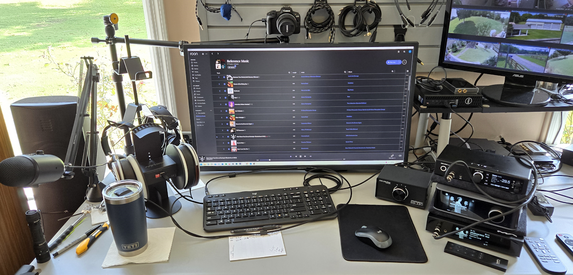
Equipment
- Headphones
- HIFIMAN HE1000se (35 ohm / 96dB sensitivity / 8Hz-65kHz FR) – $1699
- Audio Switchers
- Douk Audio ONE Little Bear MC635 – (6.35mm TRS Audio Switcher)
- Zynsonix Audio 4-pin XLR Balanced Audio Switcher – (Custom-built by Bryan Fox of Zynsonix Audio)
- Signal Management & Measurement Tools
- LiNKFOR Digital Optical Audio Splitter
- miniDSP EARS Rig (for level matching) – miniDSP.com
- Room EQ Wizard – roomeqwizard.com
- Prism Sound dScope M1 Analyzer – (for frequency response comparisons & THD+N if needed)
- Cables
- AudioQuest, Hart, and other high-quality neutral cables
- Network & Music Source
- Roon Nucleus One – (PC-controlled Roon system)
- iFi SilentPower LAN iPurifier Pro
- Omada 10Gb/2.5Gb Home Network
- Asustor Flashstor 6 NAS – (CD library storage)
- Streamers, DACs & Amplifiers
- WiiM Ultra Streamer/DAC – $329
- Matrix Audio mini-i Pro 4 Streamer/DAC/Amp – $959
- Eversolo DMP-A6 DAC Streamer – $859
- Topping DX9 DAC/Amp – $1299
- S.M.S.L. DO400 DAC/Amp – $499
- HIFIMAN Goldenwave Serenade DAC/Amp – $999
- RME ADI-2 DAC FS DAC/Amp – $1299
- Aune S17 Pro Class A Amp – $699
- JDS Labs Atom DAC 2/Atom Amp 2 – $272.99
- iBasso DX180 DAP Streamer/DAC/Amp – $499
Out of necessity, some of the amps have heavy hours on them, as I’ve been rotating them 24/7 on my headphones for weeks. A few have zero hours intentionally, as I don’t believe in DAC or amplifier break-in. As stated earlier, amps should be neutral and transparent from the start and shouldn’t change over time. I’m also not convinced that headphones require a break-in, though some manufacturers recommend it. My HE1000se headphones sound the same today as they did several hundred hours ago. If they have changed, I certainly haven’t noticed it.
Listening Comparisons: Round One
The first round of testing compares the RME ADI-2 DAC FS headphone amp and the Matrix Audio mini-i Pro 4 headphone amp. It also compares the ESS ES9028Q2M DAC (used in the RME) and the ESS ES9039Q2M DAC (used in the Matrix). The WiiM Ultra will feed the RME via digital optical, while the Matrix will use its built-in streamer/DAC.
This section will outline how I handle these comparisons and what I’ll listen for.
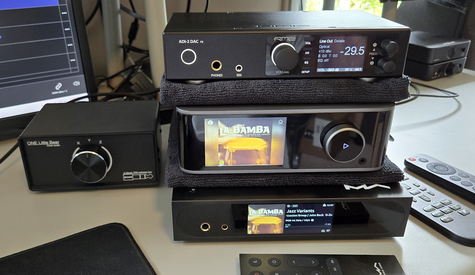
WiiM Ultra
- SNR: 121 dB (A-weighted)
- THD+N (1 kHz): 0.00018% (-115 dB) for 44.1kHz to 192kHz
- Frequency Response: ±0.05 dB
The WiiM runs fixed full volume via digital optical to the RME ADI-2 DAC FS.
RME ADI-2 DAC FS – ESS ES9028Q2M DAC
- Output: 6.3 mm TRS jack, unbalanced, stereo
- Output impedance: 0.1 Ohm
- Signal-to-noise ratio (SNR) @ +22 dBu: 120 dB RMS unweighted, 123 dBA
- Signal-to-noise ratio (SNR) @ +7 dBu: 118 dB RMS unweighted, 121 dBA
- Output level at 0 dBFS, High Power, load 100-Ohm or up: +22 dBu (10 V)
- Output level at 0 dBFS, Low Power, load 8-Ohm or up: +7 dBu (1.73 V)
- THD @ +18 dBu, 32-ohm load, 1.2 watts: -120 dB, 0.0001 %
- THD+N @ + 18 dBu, 32-Ohm Load: -114 dB, 0.0002 %
- THD @ +14 dBu, 16-Ohm load, 0.94 Watt: -110 dB, 0.0003 %
- Max power @ 0.001% THD: 1.5 W per channel
vs.
Matrix Audio mini-i Pro 4 – ESS ES9039Q2M DAC
- Output: 6.35mm unbalanced
- SNR: 116 dB A-weighted
- THD+N: <0.0005% @ 20Hz-20kHz 2VRMS
- Output Impedance: <11Ω
- Output Power: 1200mW @ 33Ω
In this first round, with the Matrix amp using its own DAC/streamer, Should I hear any differences, I will have to swap them to determine whether it is one of the streamers or one of the amps.
Since the Matrix uses its own DAC/streamer, I’ll need to swap sources if I hear differences to determine if they’re caused by the streamer or the amp. Both units have a flat frequency response (20Hz-20kHz), and after comparing the filters, I couldn’t hear any differences, likely because the filters only affect frequencies beyond human hearing. Remember, you can click on the graphs to enlarge them.
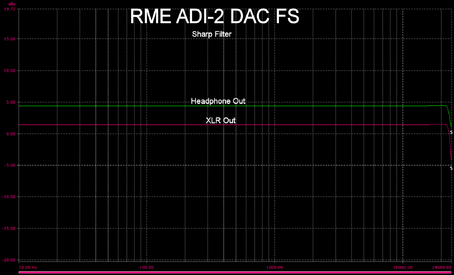
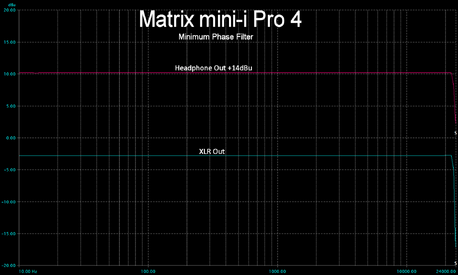
Volume-matching can be tricky, but I got the two amps within 0.1 dB of each other at my preferred listening levels of 88 dB and 78 dB. Frequency response measurements for both amps on the HEKse headphones were nearly identical at both levels, less than 1 dB (within 0.4 dB).
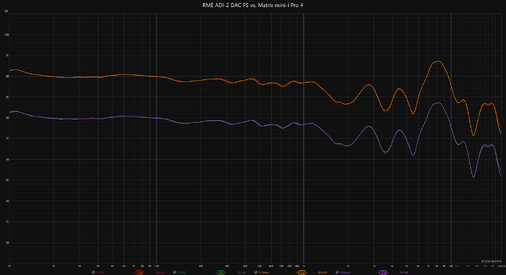
To begin the comparisons, I listened to 5-10 seconds of several specific lossless tracks of varying resolution from my reference playlist. These are mostly songs I’ve been listening to for personal enjoyment and in our evaluations over the last 15 years. Some are newer and fresher, but I’ve heard most of them in several systems for years. I'm including a few that I just recently discovered because I feel they have excellent detail.
I switch back and forth between the amps while playing the 5-10-second segment of the track over and over, listening to the following:
- Paying close attention to each specific instrument to determine if I can hear any differences in the timbre, texture, or decay in each instrument's sound. (Repeat for each instrument.)
- Does any instrument or sound seem softer, brighter, or harsher on one amp or the other?
- Are the instruments and vocals imaging the same between amps?
- Does the soundstage width or depth shift between amps?
- For sub-bass-heavy songs, can I feel the rumble with each amp?
- Does any amp have more impact or punch in the bass/mid-bass or lack anything compared to another?
- Are vocals the same, or does any amp exhibit a sharpness or sibilance?
- Are the exact details and clarity noted on all amps?
- If I notice something particular on a song, can I switch to another amp and still hear it?
- Is any distortion noticed in any amp?
- Does any amp have a quieter background noise?
Sidenote: Please don’t pull a Danny Ritchie on me and tell me I don’t know what I’m listening for. That’s not meant to be antagonistic toward Danny, as he is a good friend, and he was right to call out some of the newer reviewers on his YouTube video. I know and hear these differences when listening to different speakers and headphones. I suspect it will be more difficult for me with headphone amps, just based on my experiences with home amps, but I won’t know for sure until I listen.
Let Round One comparisons begin!
I immediately heard a difference in the first song of my test... a first for me.
Test Track: Fink – "Trouble’s What You’re In" (Live, 2012 – Wheels Turn Beneath My Feet, FLAC 44.1kHz 16-bit).
Fink slaps his guitar at the start of the track, creating a kick drum-like sound centered at 60Hz (confirmed via measurements). This slap was more pronounced on the RME ADI-2 DAC FS, with noticeably more resonance. Switching between amps, the difference was immediately apparent, but strangely, it didn’t appear in my frequency response measurements.
So, I measured the song using Room EQ Wizard’s RTA tool (30 averages) and found that 60Hz was louder on the RME. Above 100Hz, the frequency response was nearly identical, which explained why bass felt stronger on the RME while vocals sounded the same.
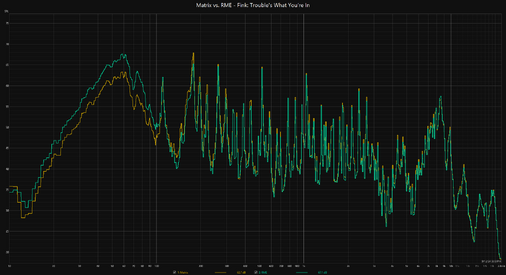
Now, the real question: What's causing this? To test further, I increased the Matrix mini-i Pro 4’s volume by 5 dB and remeasured both amps. Suddenly, the bass was level-matched, but now the midrange and vocals were louder on the Matrix, making it louder overall during quick A/B switching.
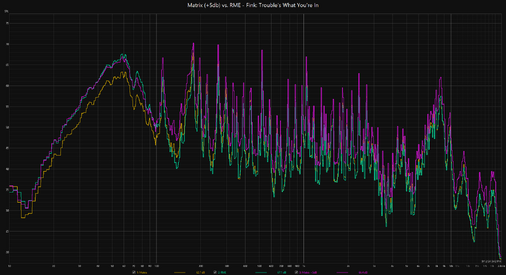
Still confused, I played full-range pink noise through both amps and analyzed the results.
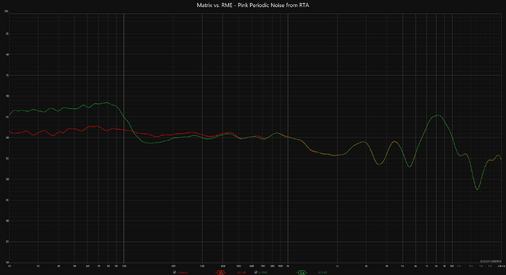
The RME showed a 5dB bass boost as if a low-shelf EQ filter at 100Hz had been applied. However, all EQ settings in the RME were off, and the loudness setting was off, so the amp wasn’t altering the signal.
At this point, I suspected the issue wasn’t the amp but the source feeding it. I opened the WiiM Ultra app and checked its input settings for the first time. That’s when I found the Ethernet input EQ was ON, applying a 100Hz low-shelf boost. This setting wasn’t enabled for USB, which explains why my initial measurements didn’t reveal the discrepancy. I hadn’t touched these settings, so either this was a factory setting (doubtful), or I received a returned unit from Amazon (probable).
In one sense, I proved I could hear a difference in amps, even if a filter helped me a bit.
I measured the song and the pink noise file again.
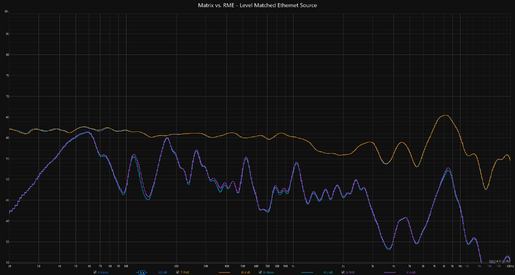
It's very close… within 0.2 dB. I listened to Fink to see if trouble’s what I'm in. With the EQ setting corrected, I switched between the amps. This time, there was zero difference. The 60Hz guitar slap sounded identical, vocals were perfectly matched, and string plucks were identical between both amps. Both amps sounded excellent with the HEKse headphones.
These amps featured the ESS ES9028Q2M DAC vs. the ESS ES9039Q2M DAC. There are no differences between the DACs. Thus, implementations of their respective DACs appear to be well done.
I could have easily skipped mentioning the initial EQ issue, but I felt it was worth including. This experience perfectly illustrates why measurements matter. If I had trusted my ears alone, I might have concluded that the RME had a better bass response... but in reality, it was simply an EQ setting on the streamer. This serves as a warning: Without properly controlled testing, we might hear differences that don’t actually exist.
With that resolved, let’s move on to Round Two.
Listening Comparisons: Round Two
I’m keeping the RME ADI-2 DAC FS in the mix for this round and adding the Topping DX9 and the HIFIMAN Goldenwave Serenade headphone amps. The WiiM Ultra continues to feed all three amps via optical output. This test also serves as a DAC comparison, pitting the ESS ES9028Q2M DAC (RME) against the Hymalaya Pro R2R DAC (Serenade) and the AKM AK4499EQ DAC (DX9).
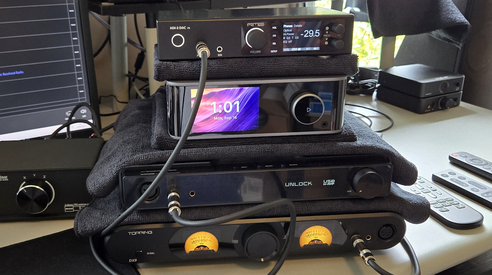
WiiM Ultra
- SNR: 121 dB (A-weighted)
- THD+N (1 kHz): 0.00018% (-115 dB) for 44.1kHz to 192kHz
- Frequency Response: ±0.05 dB
RME ADI-2 DAC FS – ESS ES9028Q2M DAC
- Output: 6.3 mm TRS jack, unbalanced, stereo
- Output impedance: 0.1 Ohm
- Signal-to-noise ratio (SNR) @ +22 dBu: 120 dB RMS unweighted, 123 dBA
- Signal-to-noise ratio (SNR) @ +7 dBu: 118 dB RMS unweighted, 121 dBA
- Output level at 0 dBFS, High Power, load 100-Ohm or up: +22 dBu (10 V)
- Output level at 0 dBFS, Low Power, load 8-Ohm or up: +7 dBu (1.73 V)
- THD @ +18 dBu, 32-ohm load, 1.2 watts: -120 dB, 0.0001 %
- THD+N @ + 18 dBu, 32-Ohm Load: -114 dB, 0.0002 %
- THD @ +14 dBu, 16-Ohm load, 0.94 Watt: -110 dB, 0.0003 %
- Max power @ 0.001% THD: 1.5 W per channel
vs.
HIFIMAN Goldenwave Serenade – Hymalaya Pro R2R DAC
- Frequency Response: 20Hz-20KHz, ±0.1dB @ 1KHz
- THD+N: 0.0015%, -3dBFS @ 1KHz
- Signal-to-noise ratio: -110dB, 0dBFS @ 1KHz
- Channel Separation: -120dB, 0dBFS @ 1KHz
- DAC Output Level: 4.5V (XLR), 2.2V (RCA), 0dBFS @ 1KHz
- Headphone Amplifier Power Output:
- Balanced output: 4000mW @ 32Ω, 760mW @ 300Ω
- Single-ended output: 2800mW @ 32Ω, 510mW @ 300Ω
vs.
Topping DX9 – AKM AK4499EQ DAC
- THD+N @ 1kHz (SE/BAL): <0.00010% @ Output = 550mW (32Ω) | <0.00007% @ Output = 550mW (32Ω)
- Frequency Response (High/Low): 20Hz-20kHz (+0.3dB) / 20Hz-40kHz (+0.6dB)
- Output Level SE (Low/High): 12V peak / 24V peak
- Output Power (SE):
- 3300mW x2 @ 16Ω
- 2100mW x2 @ 32Ω
- 4250mW x2 @ 64Ω
- 1190mW x2 @ 64Ω
- 240mW x2 @ 300Ω
- Output Power (BAL):
- 10000mW x2 @ 16Ω
- 7080mW x2 @ 32Ω
- 4250mW x2 @ 64Ω
- 950mW x2 @ 300Ω
- 460mW x2 @ 600Ω
The frequency response is relatively flat across all three units within the audible range. At the extreme frequencies, the Serenade exhibited a 0.2 dB SPL deviation.
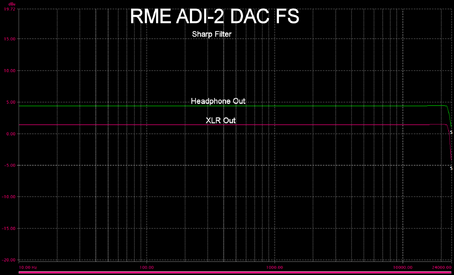
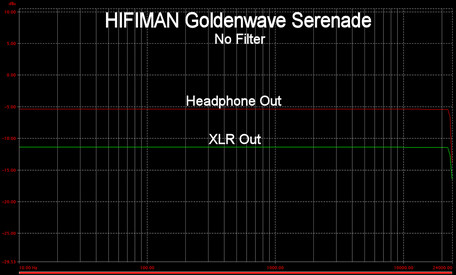
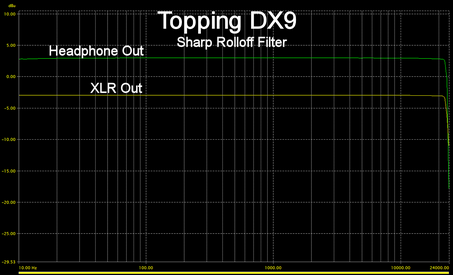
All three amps were level-matched to within 0.3 dB. The variation below 10Hz at 78 dB SPL is negligible, as sub-bass isn’t perceptible at that level. Deviations were minimal at 88 dB SPL, where sub-bass rumble becomes noticeable. I would expect to see some variations from round to round due to the slightly different placement of the headphones on the EARS rig. The Serenade lacks a volume level indicator, making precise level-matching frustrating. Every time the volume is changed, it must be manually recalibrated. This is why I appreciate a digital volume readout... it provides a consistent reference point.
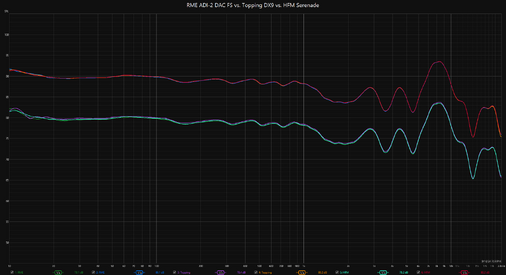
For listening criteria, see Round One. I used the same reference tracks and methodology. And once again… I hear no differences. Not even the slightest. It’s remarkable how all three amps sound exactly the same. I hoped to pick up on some small difference, but there’s nothing there. Maybe I’ll have better luck in the next round.
Listening Comparisons: Round Three
In this round, the HIFIMAN Goldenwave Serenade remains in the lineup as a reference, joined by the S.M.S.L DO400 DAC/amp and the Aune S17 Pro, which receives its signal from the Eversolo DMP-A6 DAC/Streamer. This setup allows us to compare three different DAC implementations: the Hymalaya Pro R2R DAC (Serenade), the ES9039MSPRO DAC (S.M.S.L), and the dual ES9038Q2M DACs in the Eversolo feeding the Aune S17.
For switching, I am using the Zynsonix Audio 4-pin XLR Balanced Audio Switcher, custom-built by Bryan Fox. He has a strong reputation for his handcrafted switches and cables. The 4-pin XLR cables used in this test mix two generic cables and one Hart cable, with the Hart cable connected to the Aune S17. Since high-quality 4-pin XLR cables are harder to find, I specifically sourced the Hart cable to introduce a higher-end option. Additionally, I included the iFi SilentPower LAN iPurifier Pro in the loop with the Eversolo. If I hear differences in the Aune S17 amp, I’ll swap the cables and the iPurifier Pro to determine if they contribute to any variations.
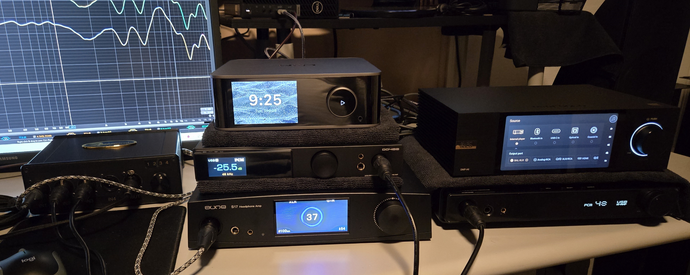
The WiiM Ultra continues to be the preamp for both the Serenade and S.M.S.L DO400, providing a fixed full-volume optical signal to both amps.
WiiM Ultra
- SNR: 121 dB (A-weighted)
- THD+N (1 kHz): 0.00018% (-115 dB) for 44.1kHz to 192kHz
- Frequency Response: ±0.05 dB
- Frequency Response: 20Hz-20KHz, ±0.1dB @ 1KHz
- THD+N: 0.0015%, -3dBFS @ 1KHz
- Signal-to-noise ratio: -110dB, 0dBFS @ 1KHz
- Channel Separation: -120dB, 0dBFS @ 1KHz
- DAC Output Level: 4.5V (XLR), 2.2V (RCA), 0dBFS @ 1KHz
- Headphone Amplifier Power Output:
- Balanced output: 4000mW @ 32Ω, 760mW @ 300Ω
- Single-ended output: 2800mW @ 32Ω, 510mW @ 300Ω
vs.
S.M.S.L DO400 - ES9039MSPRO DAC
vs.
Eversolo DMP-A6 - ES9038Q2M*2 DACs
- Frequency Response: 20Hz-20KHz (±0.15dB)
- SNR: >128dB
- THD+N: <0.00009% (-120 dB, A-weighted)
The Eversolo DMP-A6 feeds the Aune S17 Pro via XLR.
Aune S17 Pro – Amp Only
- 6.35mm Jack Headphone Output:
- Frequency Response: 20Hz - 80kHz (+/- 5dB)
- THD+N: < 0.00038% @ 1kHz
- SNR: > 115dB @ 600Ω
- Crosstalk: < -105dB @ 1kHz 600Ω
- Power Output (Low Gain):
- 738mW @ 32Ω
- 250mW @ 100Ω
- 166mW @ 150Ω
- 100mW @ 250Ω
- 83mW @ 300Ω
- 53mW @ 470Ω
- 41mW @ 600Ω
- Power Output (High Gain):
- 2020mW @ 32Ω
- 675mW @ 100Ω
- 453mW @ 150Ω
- 273mW @ 250Ω
- 228mW @ 300Ω
- 145mW @ 470Ω
- 114mW @ 600Ω
- Balanced XLR Headphone Output:
- Frequency Response: 20Hz - 80kHz (+/- 5dB)
- THD+N: < 0.00016% @ 1kHz
- SNR: > 116dB @ 600Ω
- Crosstalk: < -110dB @ 1kHz 600Ω
- Power Output (Low Gain):
- 2773mW @ 32Ω
- 968mW @ 100Ω
- 645mW @ 150Ω
- 388mW @ 250Ω
- 333mW @ 300Ω
- 212mW @ 470Ω
- 116mW @ 600Ω
- Power Output (High Gain):
- 7507mW @ 32Ω
- 2643mW @ 100Ω
- 1793mW @ 150Ω
- 1089mW @ 250Ω
- 908mW @ 300Ω
- 580mW @ 470Ω
- 453mW @ 600Ω
As expected, the frequency responses for all three amps remained flat within the audible range, with the Serenade deviating slightly at the extremes (0.2 dB SPL).

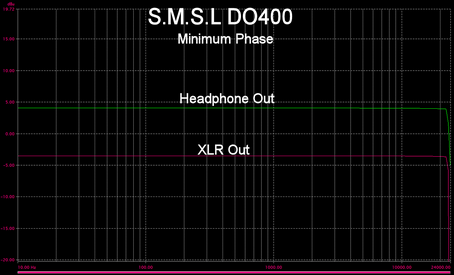
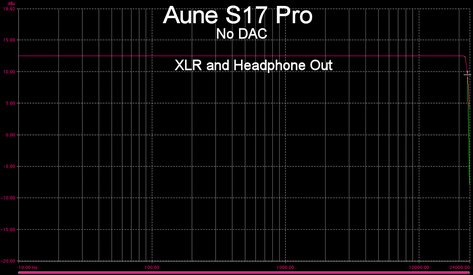
All three amps were level-matched to within 0.2 dB for low-level listening and 0.1 dB for higher-level listening.
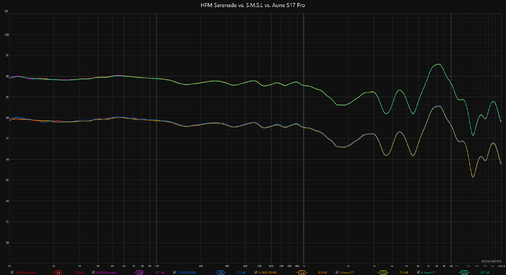
For the specific details of what I’m listening for, refer to Round One, which applies the same criteria. Unfortunately, there is still nothing to report regarding audible differences. Initially, I thought I heard something different on a few song segments, but after attempting to replicate the effect, I couldn’t. These amps all provide stunning sound quality when paired with my HEKse headphones, but as far as their differences... nothing. One side note about the Aune S17: it runs extremely hot. I could probably fry an egg on top of it.
There were no obvious sound differences between the WiiM Ultra and Eversolo DMP-A6. I personally prefer the Eversolo simply because of its larger screen, but sound-wise, there is no way to pick one over the other.
At this point, based purely on sound, I wouldn’t be able to choose between any of the amps I’ve tested so far. They all perform exceptionally well.
Listening Comparisons: Round Four (Final)
For this final round, I’m keeping the S.M.S.L DO400 with its ES9039MSPRO DAC as a reference and adding the iBasso DX180 DAP, which features Quad Cirrus Logic CS43131 DACs, along with the JDS Labs Atom DAC 2 + Atom Amp 2 bundle, which uses the older ESS 9018K2M DAC. These three will be switched using the ONE Little Bear TRS switcher, while the Eversolo DMP-A6 serves as the preamp for the S.M.S.L DO400 and JDS Labs setup. The iBasso DX180 connects directly via the PC USB port, and the DMP-A6 and DX180 are grouped in Roon for simultaneous playback.
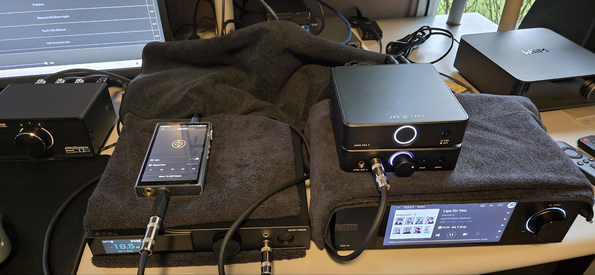
Eversolo DMP-A6 - ES9038Q2M*2 DACs
- Frequency Response: 20Hz-20KHz (±0.15dB)
- SNR: >128dB
- THD+N: <0.00009% (-120 dB, A-weighted)
The Eversolo DMP-A6 continues as a preamp, feeding a fixed full-volume optical signal to the S.M.S.L DO400 and the JDS Labs Atom DAC 2 + Amp 2 combo.
S.M.S.L DO400 - ES9039MSPRO DAC
vs.
JDS LABS Atom DAC 2 / Atom AMP 2 combo - ESS 9018K2M DAC
- Frequency Response: 20Hz-20kHz ± 0.01dB
- SINAD @ 2VRMS, 1kHz: 120 dB
- SINAD @ 50mV, 1kHz: 93 dB
- SNR (20-20kHz): 124 dB
- IMD SMPTE: -97 dB
- Noise (20-20kHz): 1.33 μV
- Crosstalk @ 10kHz (RCA Out): -101 dB
- Input Impedance: 10k Ω
- Output Impedance: 0.7 Ω
- Channel Balance: < 0.6 dB
- Max Continuous Power:
- 600Ω: 143 mW (9.28VRMS)
- 300Ω: 286 mW (9.27VRMS)
- 150Ω: 570 mW (9.25VRMS)
- 32Ω: 2.65 Watts (9.22VRMS = 26Vpp)
vs.
iBasso DX180 DAP - Quad (x4) Cirrus Logic CS43131 DACs
3.5mm SE Headphone Output
- Max Output Level: 3Vrms
- Output Power: 281mW + 281mW @ 32Ω, THD < 0.1%
- Frequency Response: 10Hz-75kHz (-1dB)
- SNR: 127dB
- Dynamic Range: 127dB
- THD+N: -116dB (A-weighted, 600Ω)
- Crosstalk: -118dB
- Noise Floor: <1.1μV (High Gain)
- Output Impedance: 0.6Ω
4.4mm Balanced Headphone Output
- Max Output Level:6Vrms
- Low Gain: 4Vrms
- Output Power:690mW + 690mW @ 32Ω, THD+N < 0.1%
- Low Gain: 500mW + 500mW @ 32Ω
- Frequency Response: 10Hz-75kHz (-1dB)
- SNR: 133dB
- Dynamic Range: 133dB
- THD+N: -121dB (A-weighted, 600Ω)
- Crosstalk: -144dB
- Noise Floor: <1.1μV (High Gain)
- Output Impedance: 1.1Ω
As expected, all three amps measure flat within the audible range.

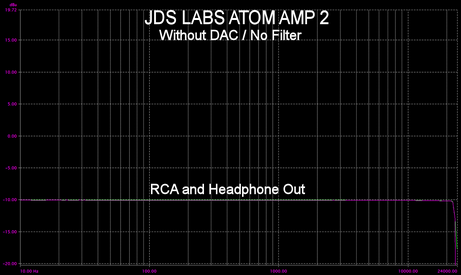
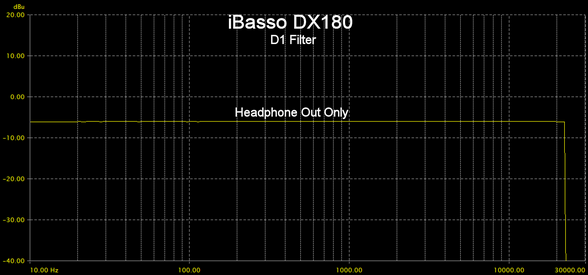
All amps were level-matched within 0.2 dB for both listening levels. Like the Serenade, the JDS Labs Atom Amp 2 lacks a volume display, making level-matching a hassle. Any volume adjustment requires manually re-matching the levels.
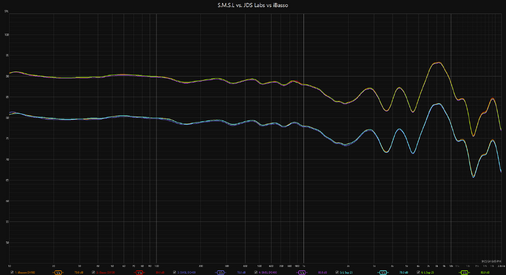
Amazingly, the iBasso DX180 holds its own against all of these desktop amps. Its Quad Cirrus Logic CS43131 DACs deliver a sound indistinguishable from the other amps in the test. The JDS Labs Atom 2 combo, despite being the least expensive amp in this comparison and costing just over half the price of the DX180, performs just as well as the most expensive units tested.
Beyond its sonic performance, the DX180's portability adds to its appeal. It contains my entire CD music library on its SD card, making it a self-contained source I can use anywhere in the house or on the go. Its Roon compatibility is another bonus, allowing it to be grouped seamlessly with my other streamers for multi-room listening. Its 4.4mm balanced headphone output provides ample power and sufficient headroom when driving my HFM HEKse headphones or UM Mest MKII IEMs. While it could eliminate the need for an additional desktop amp, that wouldn’t be as fun... after all, as an enthusiast, I need multiple amps, even if there's no justifiable reason beyond wanting them.
Conclusion
At the start of my comparison investigation, I asked myself a simple question: Are there audible differences between headphone amps? After weeks of controlled comparisons, measurements, and even some blind tests, my answer remains the same: If differences exist, they are so subtle that they don’t impact my listening experience. That doesn’t mean others won’t hear something, but I personally couldn’t reliably distinguish any amp from another when level-matched and played through the same source. If comparing, be honest about what you hear and, if possible, use a controlled testing environment to minimize bias.
This test did reaffirm one thing... comparing speakers and headphones is more fun because I can hear those differences.
So, what am I keeping?
- S.M.S.L DO400 – because I like the Sound Color options for fun.
- RME ADI-2 DAC FS – for its loudness feature that enhances low-volume listening.
- DX180 – because it's already part of my setup and makes for an excellent portable DAP.
- The Serenade & JDS Labs – no digital volume display (I know, I’m picky!).
- Topping DX9 – too much bling (clear top) and gets warm.
- Aune S17 Pro – way too hot to touch at times.
The End!







